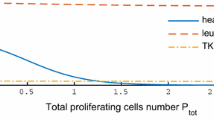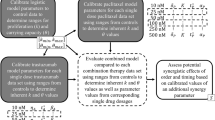Abstract
A mathematical model is presented to investigate the ordering phenomenon observed in the comparison of alternating to sequential regimens of CMF (cyclophosphamid, methotrexate, 5-fluorouracil) and doxorubicin used in breast cancer chemo-therapy. The ordinary differential equation model incorporates cell cycle specificity and resistance to study why doses of the same drugs given in different orders result in different clinical outcomes. The model employs a pulsing condition to simulate treatment and induced resistance, and we investigate treatment outcome by simulating a patient population by varying parameters using uniform distributions. The results of these simulations correspond to those observed in prior clinical studies and suggest that drug resistance might be a key mechanism in the sequential regimen’s superiority.
Similar content being viewed by others
References
Bast, R. C. et al. (Eds.) (2005). Cancer medicine. New York: Decker.
Bonadonna, G., Zambetti, M., & Valagussa, P. (1991). Sequential or alternating doxorubicin and CMF regimens in breast cancer with more than three positive nodes. J. Am. Med. Assoc., 7, 542–547.
Ecker, J., & Kupferschmid, M. (2004). Introduction to operations research. Melbourne: Krieger.
Edelstein-Keshet, L. (1988). Mathematical models in biology. New York: McGraw-Hill.
Chaudhary, P., & Roninson, I. (1993). Induction of multidrug resistance in human cells by transient exposure to different chemotherapeutic drugs. J. Natl. Cancer Inst., 85, 632–639.
Goldie, J., & Coldman, A. (1983). Quantitative model for multiple levels of drug resistance in clinical tumors. Cancer Treat. Rep., 67, 923–931.
Gringauz, A. (1997). Introduction to medicinal chemistry: how drugs act and why. New York–Weinheim: Wiley–VCH.
Michelson, S., & Slate, D. (1992). A mathematical model of the p-glycoprotein pump as a mediator of multidrug resistance. Bull. Math. Biol., 54, 1023–1038.
Motwani, M., Delohery, T., & Schwartz, G. (1999). Sequential dependent enhancement of caspase activation and apoptosis by flavopiridol on paclitaxel-treated human gastric and breast cancer cells. Clin. Cancer Res., 5, 1876–1883.
Motwani, M. et al. (2003). Flavopiridol enhances the effect of docetaxel in vitro and in vivo in human gastric cancer cells. Mol. Cancer Ther., 2, 549–555.
Norton, L., & Simon, R. (1977). Tumor size, sensitivity to therapy, and design of treatment schedules. Cancer Treat. Rep., 61, 1307–1317.
Norton, L., & Simon, R. (1986). The Norton–Simon hypothesis revisited. Cancer Treat. Rep., 70, 163–169.
Panetta, J., & Adam, J. (1995). A mathematical model of cycle-specific chemotherapy. Math. Comput. Model., 22, 67–82.
Silvestrini, R. et al. (2000). Cell proliferation and outcome following doxorubicin plus CMF regimens in node-positive breast cancer. Int. J. Cancer, 87, 405–411.
Takahashi, M. (1966). Theoretical basis for cell cycle analysis I: labelled mitosis wave method. J. Theor. Biol., 13, 202–211.
Takahashi, M. (1968). Theoretical basis for cell cycle analysis II: further studies on labelled mitosis wave method. J. Theor. Biol., 18, 195–209.
Tannock, I., & Hill, R. (1998). The basic science of oncology (3rd ed.). New York: McGraw-Hill.
Weldon, T. E. (1988). Mathematical models in cancer research. Bristol: Hilger.
Westman, J., Fabijona, B., Kern, D., & Hanson, F. (2001). Cancer treatment using multiple chemotherapeutic agents subject to drug resistance. In Proceedings of the 15th international symposium on mathematical theory of networks and systems.
Author information
Authors and Affiliations
Corresponding author
Rights and permissions
About this article
Cite this article
Roe-Dale, R., Isaacson, D. & Kupferschmid, M. A Mathematical Model of Breast Cancer Treatment with CMF and Doxorubicin. Bull Math Biol 73, 585–608 (2011). https://doi.org/10.1007/s11538-010-9549-9
Received:
Accepted:
Published:
Issue Date:
DOI: https://doi.org/10.1007/s11538-010-9549-9




